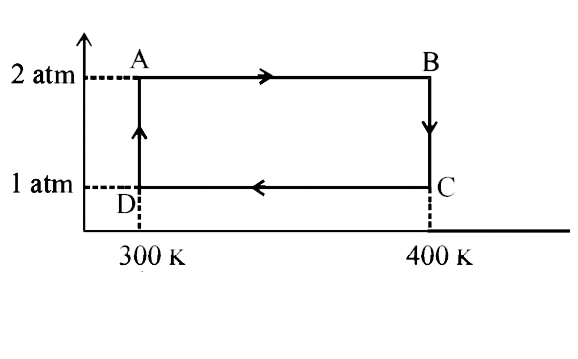Two moles of helium gas undergo a cyclic process as shown in figure. Assuming the gas to be ideal, calculate the following quantities in this process.

(a)The net change in the heat energy.
(b)The net work done.
(c )The net change in internal energy.
As we know in a cyclic process, the change in heat energy or heat supplied to the gas is equal to the net work done by the
gas.
Here AB is isobaric process. Hence work done during this process from A to B is
WAB=P(V2−V1)=nR(T2−T1)
or WAB=2×8.314×(400−300)=1662.8 joule
Workdone during isothermal process from B to C
WBC=nRTCln(V2/V1)=nRTCln(P1/P2)
= 2 x 8.314 x 400 x ln (2)
= 2 x 8.314 x 400 x 0.693
=4610.2 joule
Workdone during isobaric process from C to D
WCD=nR(TD−TC)=2×8.314×(300−400)
=-1662.8 joule
Workdone during isothermal process from D to A
WDA=nRTDln(PD/PA)
=nRTDln(2)
=-2 x 8.314 x 300 x 0.693
=-3457.7 joule
Net Workdone
=WAB+WBC+WCD+WDA
=1662.8+4610.2-1662.5 - 3457.7
=1152.5 joule
Now from first law of thermodynamics
ΔQ=ΔU+ΔW
Here ΔU=0, thus we have
ΔQ=ΔW=1152.5 joule
Sothe heat given to the system is 1152.5 joule
As the gas returns to its original state, hence there is no change in internal energy.
Topper's Solved these Questions
- THERMODYNAMICS LAWS & SPECIFIC HEATS OF GASES BOOK - PHYSICS GALAXY - ASHISH ARORACHAPTER - THERMODYNAMICS LAWS & SPECIFIC HEATS OF GASES EXERCISE - Discussion Question
17 Videos
- THERMODYNAMICS LAWS & SPECIFIC HEATS OF GASES BOOK - PHYSICS GALAXY - ASHISH ARORACHAPTER - THERMODYNAMICS LAWS & SPECIFIC HEATS OF GASES EXERCISE - Conceptual MCQs Single Option Correct
21 Videos
- PHOTOELECTRIC EFFECT AND MATTER WAVESBOOK - PHYSICS GALAXY - ASHISH ARORACHAPTER - PHOTOELECTRIC EFFECT AND MATTER WAVESEXERCISE - Unsolved numerical problems
42 Videos
- WAVE OPTICSBOOK - PHYSICS GALAXY - ASHISH ARORACHAPTER - WAVE OPTICSEXERCISE - Unsolved Numerical Problems
28 Videos
Similar Questions
Two moles of helium gas undergo a cyclic process as shown in Fig. Assuming the gas to be ideal, calculate the following quantities in this process

(a) The net change in the heat energy
(b) The net work done
(c) The net change in internal energy
View SolutionTwo moles of helium gas undergo a cyclic process as shown in Fig. Assuming the gas to be ideal, calculate the following quantities in this process
(a) The net change in the heat energy
(b) The net work done
(c) The net change in internal energy

View Solution
Knowledge Check
Two moles of helium gas undergo a cyclic process as shown in figure. Assuming the gas to be ideal. The net work done by the gas is
 A200 Rln2B100 Rln2C300 Rln2D400 Rln2
A200 Rln2B100 Rln2C300 Rln2D400 Rln2Two moles of helium gas undergo a cyclic process as shown in figure. Assuming gas to be ideal, the net heat exchange in the process will be
 A1000 JB1152 JC1200 JD1500 J
A1000 JB1152 JC1200 JD1500 JTwo moles of Helium gas undergo a reversible cyclic process as shown in figure. Assuming gas to be ideal, what is the net work involved in the cyclic process ?
 A−100Rln4B+100Rln4C+200Rln4D−200Rln4
A−100Rln4B+100Rln4C+200Rln4D−200Rln4
Two moles of helium gas undergo a cyclic process as shown in Fig. Assuming the gas to be ideal, calculate the following quantities in this process

(a) The net change in the heat energy
(b) The net work done
(c) The net change in internal energy
View SolutionTwo moles of helium gas undergo a cyclic process as shown in Fig. Assuming the gas to be ideal, calculate the following quantities in this process

(a) The net change in the heat energy
(b) The net work done
(c) The net change in internal energy
View SolutionTwo moles of helium gas undergo a cyclic process as shown in Fig. 19.2.14. Assuming the gas to be ideal, calculate the following quantitites in this process
(a) the net change in heat energy
(b) the net work done
(c) the net change in internal energy.
View SolutionTwo moles of Helium gas undergo a reversible cyclic process as shown in figure. Assuming gas to be ideal, what is the net work involved in the cyclic process ?

View SolutionTwo moles of Helium gas undergo a reversible cyclic process as shown in figure. Assuming gas to be ideal, what is the net work involved in the cyclic process ?

View Solution
